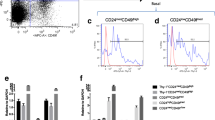Abstract
Mammary reconstitution assays can be used to measure the stem cell frequency within an epithelial population by transplanting increasingly diluted single-cell preparations of the population of interest. There are fundamental steps in the single-cell isolation protocol which are directly related to the number of single epithelial cells obtained. Once single-cell suspensions have been obtained, serial dilutions are prepared and transplanted into the cleared fat pads of the host mice. After 8–10 weeks, the transplanted fat pads are reevaluated for the presence of epithelial outgrowths. Based on the frequency of no outgrowth for each one of the transplanted dilutions, it is possible to estimate the frequency of mammary repopulating cells present in a given cell population. Here, we give details on how to carry out all these steps.
Access this chapter
Tax calculation will be finalised at checkout
Purchases are for personal use only
Similar content being viewed by others
References
DeOme KB, Faulkin LJJ, Bern HA, Blair PB (1959) Development of mammary tumors from hyperplastic alveolar nodules transplanted into gland-free mammary fat pads of female C3H mice. Cancer Res 19: 515–520
Young LJ, Medina D, DeOme KB, Daniel CW (1971) The influence of host and tissue age on life span and growth rate of serially transplanted mouse mammary gland. Exp Gerontol 6:49–56
Daniel CW, De Ome KB, Young JT, Blair PB, Faulkin LJ Jr (1968) The in vivo life span of normal and preneoplastic mouse mammary glands: a serial transplantation study. Proc Natl Acad Sci U S A 61:53–60
Gould MN, Biel WF, Clifton KH (1977) Morphological and quantitative studies of gland formation from inocula of monodispersed rat mammary cells. Exp Cell Res 107:405–416
Kamiya K, Gould MN, Clifton KH (1998) Quantitative studies of ductal versus alveolar differentiation from rat mammary clonogens. Proc Soc Exp Biol Med 219:217–225
Kim ND, Oberley TD, Yasukawa-Barnes J, Clifton KH (2000) Stem cell characteristics of transplanted rat mammary clonogens. Exp Cell Res 260:146–159
Laidlaw IJ, Clarke RB, Howell A, Owen AW, Potten CS, Anderson E (1995) The proliferation of normal human breast tissue implanted into athymic nude mice is stimulated by estrogen but not progesterone. Endocrinology 136:164–171
Clarke RB, Howell A, Anderson E (1997) Estrogen sensitivity of normal human breast tissue in vivo and implanted into athymic nude mice: analysis of the relationship between estrogen-induced proliferation and progesterone receptor expression. Breast Cancer Res Treat 45:121–133
Lenth RV (2006) Java Applets for Power and Sample Size (Computer Software] (http://www.stat.uiowa.edu/~rlenth/power)
Taswell C (1981) Limiting dilution assays for the determination of immunocompetent cell frequencies I. Data analysis. J Immunol 126: 1614–1619
Glantz SA (2005) Primer of biostatistics, McGraw-Hill Medical, New York
Fernandez-Gonzalez R (2006) In: Bioengi-neering, Vol. Ph.D., UC Berkeley/UC San Francisco, Berkeley
Acknowledgments
This work was supported by a predoctoral fellowship to RFG from the Department of Defense Breast Cancer Research Program (DAMD 17-03-1-0594), grants from the same institution to COS (DAMD 17-00-1-0227 and DAMD 17-00-1-0306), a grant to BEW from the National Cancer Institute (CA 8424306), and a grant to MHBH funded by the National Institute of Environmental Health Sciences and the National Cancer Institute (U01 ES012801).
Author information
Authors and Affiliations
Editor information
Editors and Affiliations
Appendix I
Appendix I









Rights and permissions
Copyright information
© 2010 Springer Science+Business Media, LLC
About this protocol
Cite this protocol
Illa-Bochaca, I., Fernandez-Gonzalez, R., Shelton, D.N., Welm, B.E., Ortiz-de-Solorzano, C., Barcellos-Hoff, M.H. (2010). Limiting-Dilution Transplantation Assays in Mammary Stem Cell Studies. In: Conboy, I., Schaffer, D., Barcellos-Hoff, M., Li, S. (eds) Protocols for Adult Stem Cells. Methods in Molecular Biology™, vol 621. Humana Press. https://doi.org/10.1007/978-1-60761-063-2_2
Download citation
DOI: https://doi.org/10.1007/978-1-60761-063-2_2
Published:
Publisher Name: Humana Press
Print ISBN: 978-1-60761-062-5
Online ISBN: 978-1-60761-063-2
eBook Packages: Springer Protocols




